Terraforming Mars - A Solo Review
16 Sep 2021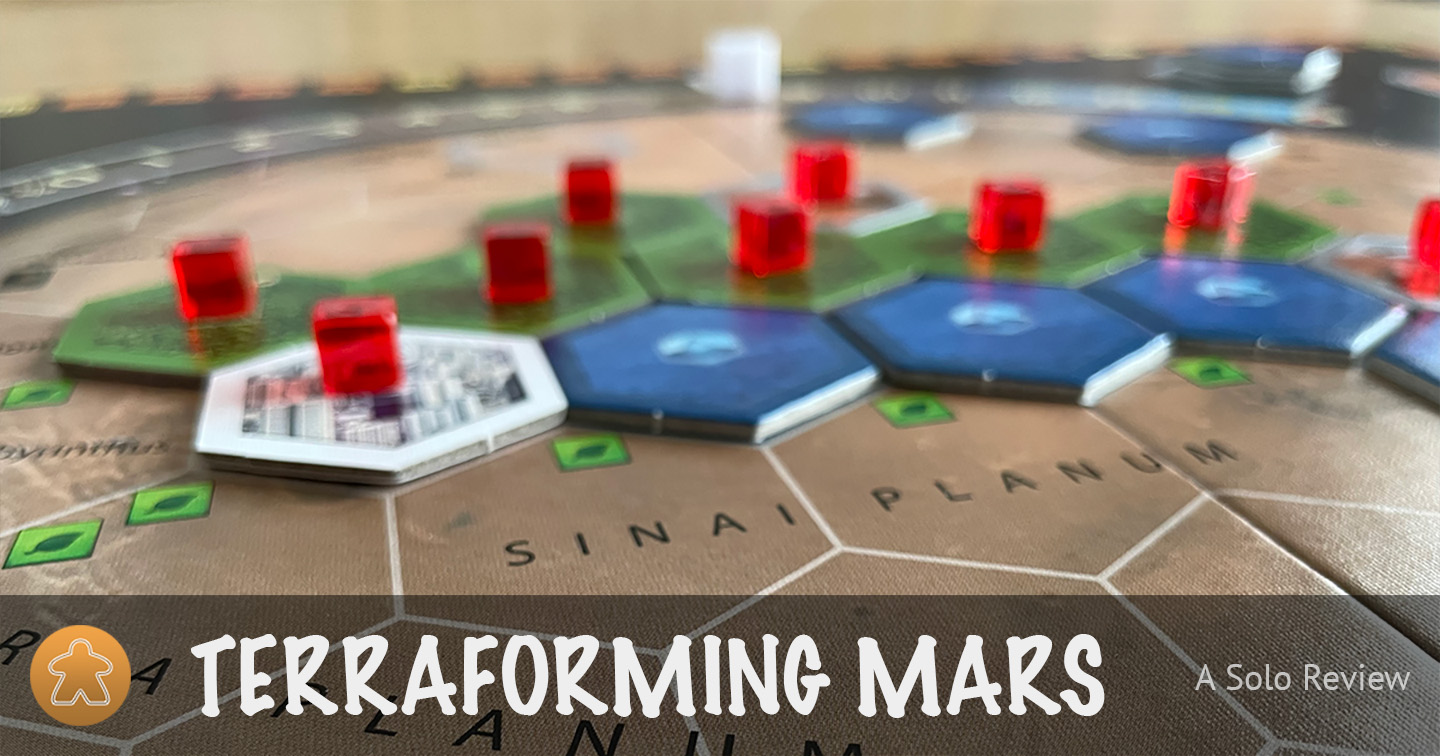
Somewhere in the 25th century we started looking at Mars as an escape plan. Things aren’t going well with Earth and a few powerful and rich corporations have taken it on themselves to turn Mars into a place where we’ll be able to live. You’re the leader of one of those corporations and you’ve promised you can get the job done in 14 generations. Will you succeed?
Name: Terraforming Mars
Designer: Jacob Fryxelius
Publisher: FryxGames / Stronghold Games
Game type: engine building, income, tile placement
What is Terraforming Mars?
Your goal in Terraforming Mars is to increase the oxygen, temperature and water on the planet to levels that make the place habitable for humans. There are various ways to increase these three parameters, but all of them require you to spend different kinds of resources, so you’ll need to build up an engine to increase your resource production as well.
Every generation –the game’s concept for a round– you gain an amount of resources determined by your production capacities. By buying and playing cards you can increase your production capacities and even directly influence the terraforming of the planet.
If you can raise all three terraforming parameters to their required levels in 14 generations or less, you win.
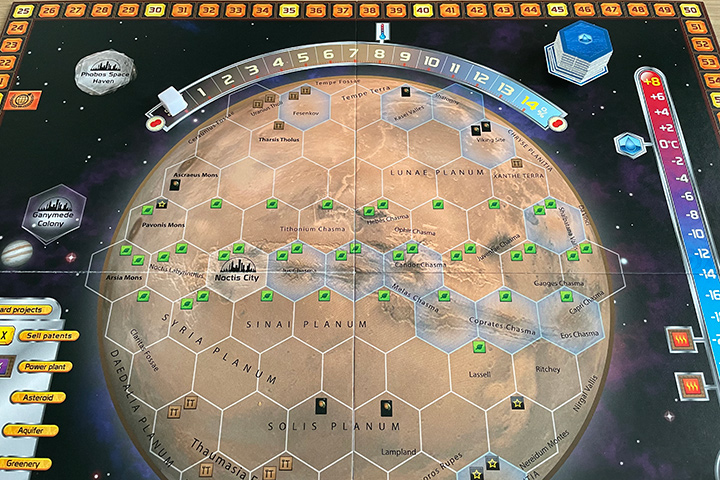
How does it play?
At the beginning of the game you draw two random corporation cards and ten random project cards. The corporation cards tell you which corporation you represent, what your starting resources are and which ongoing effect will benefit you as that corporation. The project cards represent things you can build or develop. Of these cards you can keep one corporation card and as many project cards as you want and can afford; every project card you want to keep will cost you three MegaCredits.
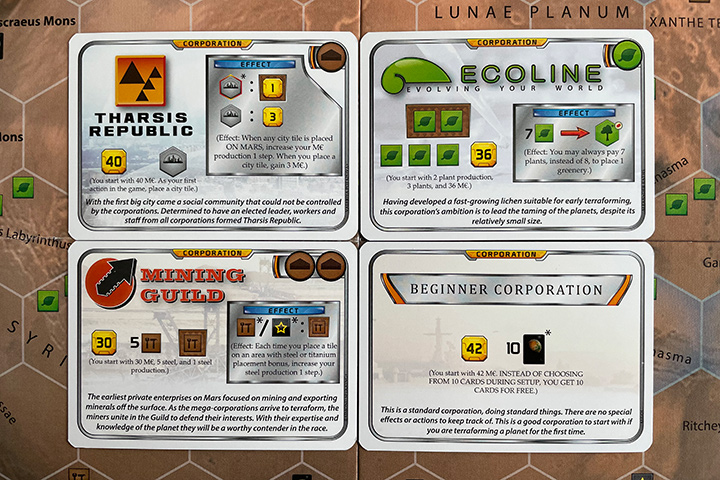
You also get a player board where you can track how much of each of the six resources you have and what your production capacity for each of them is. The different resources are MegaCredits (basically money), steel, titanium, plants, energy and heat.
The game is divided into generations and every generation is divided into a few phases.
The player order phase
In the solo game this phase is only used to advance the generation marker one step. If reaches 14, the last generation starts. This phase is skipped in the first generation.
The research phase
In this phase you can draw four project cards and buy them for three MegaCredits each. Buying a card adds it to your hand. This phase is skipped in the first generation since you got to choose from ten cards at the beginning of the game.
The action phase
This is the meat of the game. In this phase you are allowed to take as many actions as you can and want. There are a few different types of actions and most of them have a cost associated with them.
One of the actions that is always available is funding one of the so called standard projects. These are printed on the game board itself and include things like paying 11 MegaCredits to increase your energy production one step, paying 23 MegaCredits for placing a greenery tile on the board or paying 18 MegaCredits for placing an ocean tile on the board.
Another option is playing a card from your hand to your playing area if you can afford it and meet certain card specific requirements. Every card has a cost in MegaCredits shown in the top left corner. Some have a symbol indicating the card can be paid in a combination of MegaCredits and either steel or titanium. In this case steel is worth two MegaCredits while titanium is worth three. Cards come in three types. Red event cards have a one time effect (increase temperature, place a tile, …) and after resolving it you turn the card face down. Green automation cards also have a one time effect, but they get to stay face up so their symbols can contribute to meeting the requirements for playing other cards. Blue active cards can have ongoing effects (e.g. pay 2 MegaCredits less for certain cards) or you can to use them as an action once per generation (e.g. adding adding a token to the card or removing two tokens to increase temperature one step).
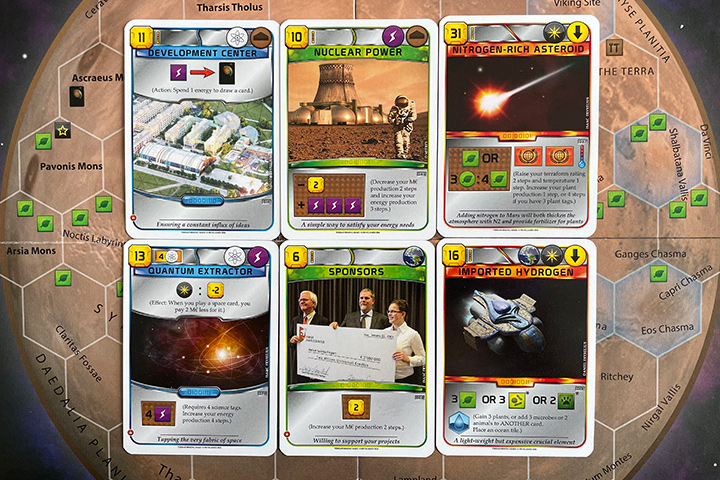
The two other actions are paying eight plants to place a greenery tile and paying eight heat to increase temperature one step.
Ultimately the goal of taking actions is helping you terraform Mars. This means increasing oxygen 14 times, temperature 19 times and placing all 9 ocean tiles.
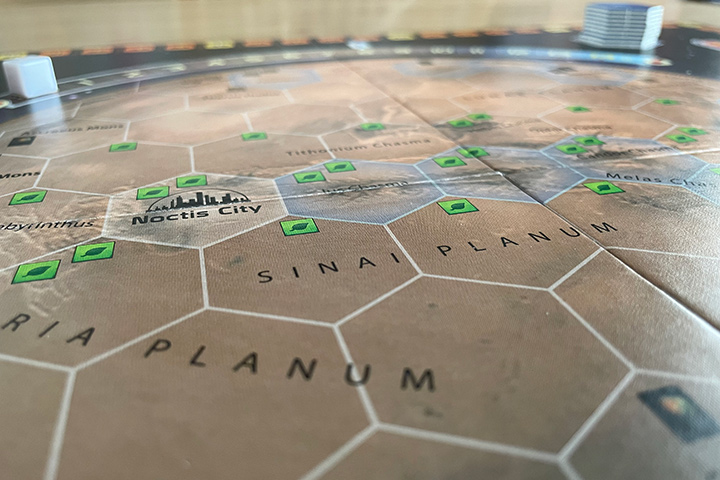
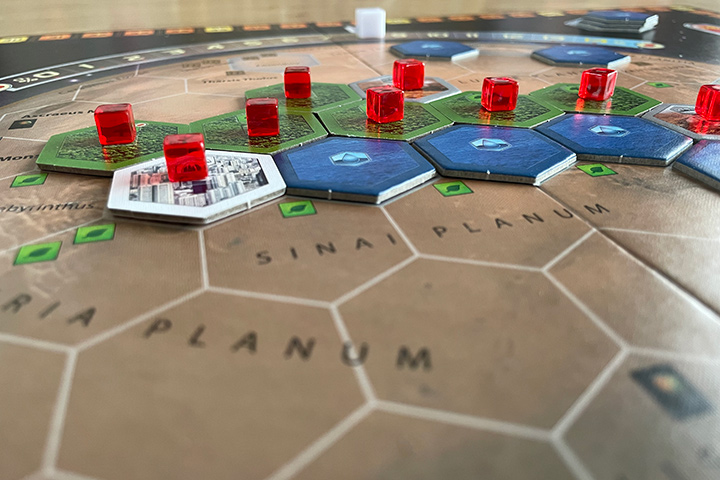
The production phase
In the production phase you get to replenish your resources after having spent them in the previous phase, but first, all leftover energy is turned into heat.
Like I’ve already mentioned, every resource has a production capacity which you can increase –or decrease!– in the action phase. During the production phase this capacity determines how much of that resource you gain. For example, if your steel production is four, you get four steel every production phase.
Every time you increase one of the terraforming parameters (oxygen, temperature, oceans) you also increase your terraform rating. This terraform rating is added to your MegaCredits production capacity when you gain your new batch of MegaCredits.
Once the production phase is over you go back to the player order phase.
How does the AI work?
Easy! There is no AI in this game! You’re completely on your own and the only thing working against you is time. You need to get the job done in 14 generations.
What does it look and feel like?
There are a few different components in this game. Most, like the game board, the coloured player cubes, the hex tiles and the cards, are OK but nothing special, just OK.
What’s nice about the cards is that they’re all pretty thematic: an event card representing an asteroid hitting Mars, which results in an increase in temperature and gives you some titanium but kills a few plants. Or aquifer pumping which makes it cheaper to place ocean tiles. What could be better is the art on them. It feels very inconsistent across the cards, as if they just purchased a load of stock photos from different artists with their own style.
Another thing that could be better is the quality of the resource cubes. These come in three different colours and sizes: small coppers ones, medium silver ones and large gold ones. These represent one, five and ten units respectively. These cubes are plastic and the colour is just a tin layer of paint. Even after a handful of games the paint was coming off around the edges of some cubes.
The complete lack of any form of insert in the box also disappointed me. Even a simple cardboard divider would have been helpful. There are over 200 cards in the game and dividing them over a few zip lock bags and tossing them in the box with the rest just feels wrong to me. Especially because the box is not even half full. There is a lot of room for things to move around.
But the biggest disappointment of them all are the player boards. These are divided into 12 sections, two per resource: one to place resource cubes on to indicate how much of the resource you have and one to place a single cube on a track to keep track of the production capacity for that resource. You can easily have over 20 cubes on your player board and the position of every single cube is important. Even the slightest bump messes things up because the smooth plastic cube slide around super easily on the smooth and thin player board.
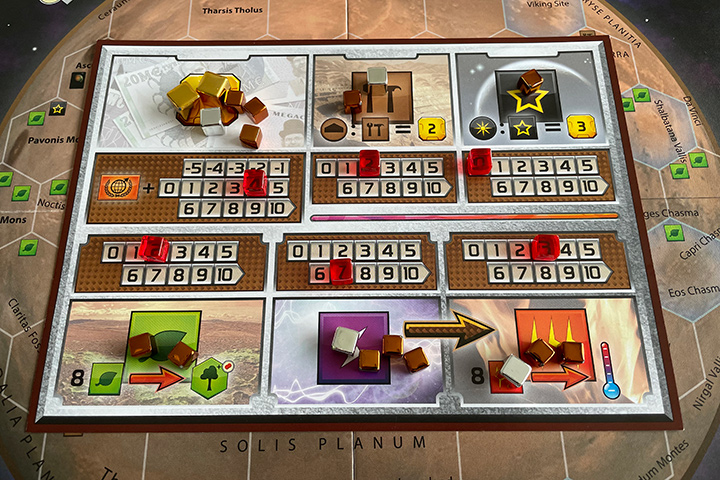
I ended up up buying an insert for the box and custom dual layered player boards. This really adds to the price of the game. Sure, you don’t need those things, but not having them was too annoying for me.
How much time does it take?
My first game took a long time; easily over two hours. Mostly because I was over thinking things. After a few plays you get a feel for what’s a good and what’s a bad move and which cards are worth buying and which you can safely skip. This brought the game time down to a little under an hour. Thanks to the insert I got for the box, I think I can play the game in about an hour including set up and tear down.
What is my verdict?
I’ll just start by saying I no longer own Terraforming Mars. I’ve sold it without regrets and I’ll tell you why.
The game contains a lot of cards that are pretty much useless in a solo game. In a multiplayer game, the player with the highest score wins once Mars has been completely terraformed. A lot of cards don’t help you build up an engine, increase your production or terraform the planet; they just give you ways to gain points. In a solo game you are trying to terraform Mars in 14 generations, you don’t care about points. If you draw enough of those cards early on in the game, you can pretty much forget it.
You know how in some games it just feels like you lost because you had bad luck when drawing cards? Well, in Terraforming Mars I also had that feeling when I won. It never felt like I won because of what I did, because most of the time it is pretty obvious what you need to do, instead, it felt like I won because I got lucky with the cards I drew.
I didn’t take me a lot of plays to feel like I had seen all the game had to offer.
Score
To make things easier for myself, I use the same scoring categories Board Game Geek uses.
Comments
I'm sorry, I don't support comments on my website. If you want to discuss the game or my review, feel free comment on this dedicated Instagram post or my review on BGG.